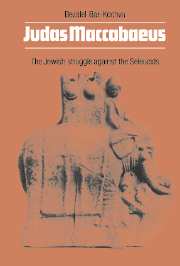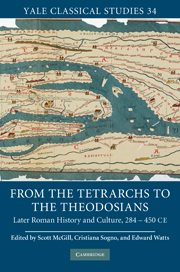Refine search
Actions for selected content:
23990 results in Ancient history
Preface and acknowledgements
-
- Book:
- Domestic Space in Classical Antiquity
- Published online:
- 05 August 2012
- Print publication:
- 05 August 2010, pp xv-xvii
-
- Chapter
- Export citation
3 - A space for ‘hurling the furniture’? Architecture and the development of Greek domestic symposia
-
- Book:
- Domestic Space in Classical Antiquity
- Published online:
- 05 August 2012
- Print publication:
- 05 August 2010, pp 43-62
-
- Chapter
- Export citation
List of figures
-
- Book:
- Domestic Space in Classical Antiquity
- Published online:
- 05 August 2012
- Print publication:
- 05 August 2010, pp x-xi
-
- Chapter
- Export citation
Period names and dates referred to in this book
-
- Book:
- Domestic Space in Classical Antiquity
- Published online:
- 05 August 2012
- Print publication:
- 05 August 2010, pp 152-152
-
- Chapter
- Export citation
Frontmatter
-
- Book:
- Domestic Space in Classical Antiquity
- Published online:
- 05 August 2012
- Print publication:
- 05 August 2010, pp i-viii
-
- Chapter
- Export citation
Bibliography
-
- Book:
- Domestic Space in Classical Antiquity
- Published online:
- 05 August 2012
- Print publication:
- 05 August 2010, pp 160-170
-
- Chapter
- Export citation
Epilogue: domestic space and social organisation in Classical Antiquity
-
- Book:
- Domestic Space in Classical Antiquity
- Published online:
- 05 August 2012
- Print publication:
- 05 August 2010, pp 142-149
-
- Chapter
- Export citation
Bibliographic essay
-
- Book:
- Domestic Space in Classical Antiquity
- Published online:
- 05 August 2012
- Print publication:
- 05 August 2010, pp 153-159
-
- Chapter
- Export citation
Map showing the locations of the sites and regions discussed in Chapters 3–6
-
- Book:
- Domestic Space in Classical Antiquity
- Published online:
- 05 August 2012
- Print publication:
- 05 August 2010, pp xviii-xviii
-
- Chapter
- Export citation
6 - Housing as symbol: elite self-presentation in North Africa under Roman rule
-
- Book:
- Domestic Space in Classical Antiquity
- Published online:
- 05 August 2012
- Print publication:
- 05 August 2010, pp 119-141
-
- Chapter
- Export citation
List of plates
-
- Book:
- Domestic Space in Classical Antiquity
- Published online:
- 05 August 2012
- Print publication:
- 05 August 2010, pp xii-xiv
-
- Chapter
- Export citation
Index
-
- Book:
- Domestic Space in Classical Antiquity
- Published online:
- 05 August 2012
- Print publication:
- 05 August 2010, pp 171-178
-
- Chapter
- Export citation
5 - Seeking the domus behind the dominus in Roman Pompeii: artefact distributions as evidence for the various social groups
-
- Book:
- Domestic Space in Classical Antiquity
- Published online:
- 05 August 2012
- Print publication:
- 05 August 2010, pp 89-118
-
- Chapter
-
- You have access
- Export citation
2 - House-form and social complexity: the transformation of Early Iron Age Greece
-
- Book:
- Domestic Space in Classical Antiquity
- Published online:
- 05 August 2012
- Print publication:
- 05 August 2010, pp 22-42
-
- Chapter
- Export citation
1 - Domestic space and social organisation
-
- Book:
- Domestic Space in Classical Antiquity
- Published online:
- 05 August 2012
- Print publication:
- 05 August 2010, pp 3-21
-
- Chapter
- Export citation

Judas Maccabaeus
- The Jewish Struggle Against the Seleucids
-
- Published online:
- 04 August 2010
- Print publication:
- 13 April 1989
The Seleucid Army
- Organization and Tactics in the Great Campaigns
-
- Published online:
- 04 August 2010
- Print publication:
- 13 May 1976

From the Tetrarchs to the Theodosians
- Later Roman History and Culture, 284–450 CE
-
- Published online:
- 04 August 2010
- Print publication:
- 01 April 2010
List of Illustrations
-
- Book:
- The Gods of Ancient Greece
- Published by:
- Edinburgh University Press
- Published online:
- 05 August 2013
- Print publication:
- 30 July 2010, pp x-xiii
-
- Chapter
- Export citation
3 - Gods in Greek Inscriptions: Some Methodological Questions
- from PART I - SYSTEMATIC ASPECTS
-
-
- Book:
- The Gods of Ancient Greece
- Published by:
- Edinburgh University Press
- Published online:
- 05 August 2013
- Print publication:
- 30 July 2010, pp 55-80
-
- Chapter
- Export citation
